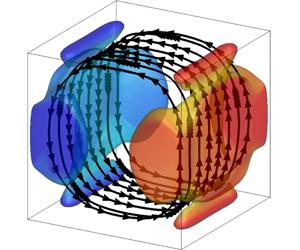当前位置:
X-MOL 学术
›
J. Fluid Mech.
›
论文详情
Our official English website, www.x-mol.net, welcomes your feedback! (Note: you will need to create a separate account there.)
Reduced-order modelling of radiative transfer effects on Rayleigh–Bénard convection in a cubic cell
Journal of Fluid Mechanics ( IF 3.7 ) Pub Date : 2020-06-24 , DOI: 10.1017/jfm.2020.395 Laurent Soucasse , Bérengère Podvin , Philippe Rivière , Anouar Soufiani
Journal of Fluid Mechanics ( IF 3.7 ) Pub Date : 2020-06-24 , DOI: 10.1017/jfm.2020.395 Laurent Soucasse , Bérengère Podvin , Philippe Rivière , Anouar Soufiani

|
This paper presents a reduced-order modelling strategy for Rayleigh-Benard convection of a radiating gas, based on the proper orthogonal decomposition (POD). Direct numerical simulation (DNS) of coupled natural convection and radiative transfer in a cubic Rayleigh-Benard cell is performed for an air/H 2 O/CO 2 mixture at room temperature and at a Rayleigh number of 10 7. It is shown that radiative transfer between the isothermal walls and the gas triggers a convection growth outside the boundary-layers. Mean and turbulent kinetic energy increase with radiation, as well as temperature fluctuations to a lesser extent. As in the uncoupled case, the large-scale circulation (LSC) settles in one of the two diagonal planes of the cube with a clockwise or anticlockwise motion, and experiences occasional brief reorientations which are rotations of π/2 of the LSC in the horizontal plane. A POD analysis is conducted and reveals that the dominant POD eigenfunctions are preserved with radiation while POD eigenvalues are increased. Two POD-based reduced-order models including radiative transfer effects are then derived: the first one is based on coupled DNS data while the second one is an a priori model based on uncoupled DNS data. Owing to the weak temperature differences, radiation effects on mode amplitudes are linear in the models. Both models capture the increase in energy with radiation and are able to reproduce the low-frequency dynamics of reorientations and the high-frequency dynamics associated with the LSC velocity observed in the coupled DNS.
中文翻译:

立方晶胞中 Rayleigh-Bénard 对流的辐射传递效应的降阶建模
本文提出了一种基于适当正交分解 (POD) 的辐射气体 Rayleigh-Benard 对流的降阶建模策略。在室温和瑞利数为 10 7 的情况下,对空气/H 2 O/CO 2 混合物在立方瑞利-贝纳德单元中进行耦合自然对流和辐射传递的直接数值模拟 (DNS)。等温壁和气体之间的转移触发了边界层外的对流增长。平均和湍流动能随着辐射增加,温度波动也较小。与非耦合情况一样,大尺度环流 (LSC) 以顺时针或逆时针运动位于立方体的两个对角平面之一中,并且偶尔会经历短暂的重新定向,即 LSC 在水平面上旋转 π/2。进行了 POD 分析并显示主要 POD 特征函数在辐射下得以保留,而 POD 特征值增加。然后推导出包括辐射传输效应在内的两个基于 POD 的降阶模型:第一个基于耦合 DNS 数据,而第二个是基于非耦合 DNS 数据的先验模型。由于微弱的温差,辐射对模式振幅的影响在模型中是线性的。两种模型都捕获了辐射能量的增加,并且能够重现重新定向的低频动态以及与耦合 DNS 中观察到的 LSC 速度相关的高频动态。进行了 POD 分析并显示主要 POD 特征函数在辐射下得以保留,而 POD 特征值增加。然后推导出包括辐射传输效应在内的两个基于 POD 的降阶模型:第一个基于耦合 DNS 数据,而第二个是基于非耦合 DNS 数据的先验模型。由于微弱的温差,辐射对模式振幅的影响在模型中是线性的。两种模型都捕获了辐射能量的增加,并且能够重现重新定向的低频动态以及与耦合 DNS 中观察到的 LSC 速度相关的高频动态。进行了 POD 分析并显示主要 POD 特征函数在辐射下得以保留,而 POD 特征值增加。然后推导出包括辐射传输效应在内的两个基于 POD 的降阶模型:第一个基于耦合 DNS 数据,而第二个是基于非耦合 DNS 数据的先验模型。由于微弱的温差,辐射对模式振幅的影响在模型中是线性的。两种模型都捕获了辐射能量的增加,并且能够重现重新定向的低频动态以及与耦合 DNS 中观察到的 LSC 速度相关的高频动态。然后推导出包括辐射传输效应在内的两个基于 POD 的降阶模型:第一个基于耦合 DNS 数据,而第二个是基于非耦合 DNS 数据的先验模型。由于微弱的温差,辐射对模式振幅的影响在模型中是线性的。两种模型都捕获了辐射能量的增加,并且能够重现重新定向的低频动态以及与耦合 DNS 中观察到的 LSC 速度相关的高频动态。然后推导出包括辐射传输效应在内的两个基于 POD 的降阶模型:第一个基于耦合 DNS 数据,而第二个是基于非耦合 DNS 数据的先验模型。由于微弱的温差,辐射对模式振幅的影响在模型中是线性的。两种模型都捕获了辐射能量的增加,并且能够重现重新定向的低频动态以及与耦合 DNS 中观察到的 LSC 速度相关的高频动态。
更新日期:2020-06-24
中文翻译:

立方晶胞中 Rayleigh-Bénard 对流的辐射传递效应的降阶建模
本文提出了一种基于适当正交分解 (POD) 的辐射气体 Rayleigh-Benard 对流的降阶建模策略。在室温和瑞利数为 10 7 的情况下,对空气/H 2 O/CO 2 混合物在立方瑞利-贝纳德单元中进行耦合自然对流和辐射传递的直接数值模拟 (DNS)。等温壁和气体之间的转移触发了边界层外的对流增长。平均和湍流动能随着辐射增加,温度波动也较小。与非耦合情况一样,大尺度环流 (LSC) 以顺时针或逆时针运动位于立方体的两个对角平面之一中,并且偶尔会经历短暂的重新定向,即 LSC 在水平面上旋转 π/2。进行了 POD 分析并显示主要 POD 特征函数在辐射下得以保留,而 POD 特征值增加。然后推导出包括辐射传输效应在内的两个基于 POD 的降阶模型:第一个基于耦合 DNS 数据,而第二个是基于非耦合 DNS 数据的先验模型。由于微弱的温差,辐射对模式振幅的影响在模型中是线性的。两种模型都捕获了辐射能量的增加,并且能够重现重新定向的低频动态以及与耦合 DNS 中观察到的 LSC 速度相关的高频动态。进行了 POD 分析并显示主要 POD 特征函数在辐射下得以保留,而 POD 特征值增加。然后推导出包括辐射传输效应在内的两个基于 POD 的降阶模型:第一个基于耦合 DNS 数据,而第二个是基于非耦合 DNS 数据的先验模型。由于微弱的温差,辐射对模式振幅的影响在模型中是线性的。两种模型都捕获了辐射能量的增加,并且能够重现重新定向的低频动态以及与耦合 DNS 中观察到的 LSC 速度相关的高频动态。进行了 POD 分析并显示主要 POD 特征函数在辐射下得以保留,而 POD 特征值增加。然后推导出包括辐射传输效应在内的两个基于 POD 的降阶模型:第一个基于耦合 DNS 数据,而第二个是基于非耦合 DNS 数据的先验模型。由于微弱的温差,辐射对模式振幅的影响在模型中是线性的。两种模型都捕获了辐射能量的增加,并且能够重现重新定向的低频动态以及与耦合 DNS 中观察到的 LSC 速度相关的高频动态。然后推导出包括辐射传输效应在内的两个基于 POD 的降阶模型:第一个基于耦合 DNS 数据,而第二个是基于非耦合 DNS 数据的先验模型。由于微弱的温差,辐射对模式振幅的影响在模型中是线性的。两种模型都捕获了辐射能量的增加,并且能够重现重新定向的低频动态以及与耦合 DNS 中观察到的 LSC 速度相关的高频动态。然后推导出包括辐射传输效应在内的两个基于 POD 的降阶模型:第一个基于耦合 DNS 数据,而第二个是基于非耦合 DNS 数据的先验模型。由于微弱的温差,辐射对模式振幅的影响在模型中是线性的。两种模型都捕获了辐射能量的增加,并且能够重现重新定向的低频动态以及与耦合 DNS 中观察到的 LSC 速度相关的高频动态。



























 京公网安备 11010802027423号
京公网安备 11010802027423号